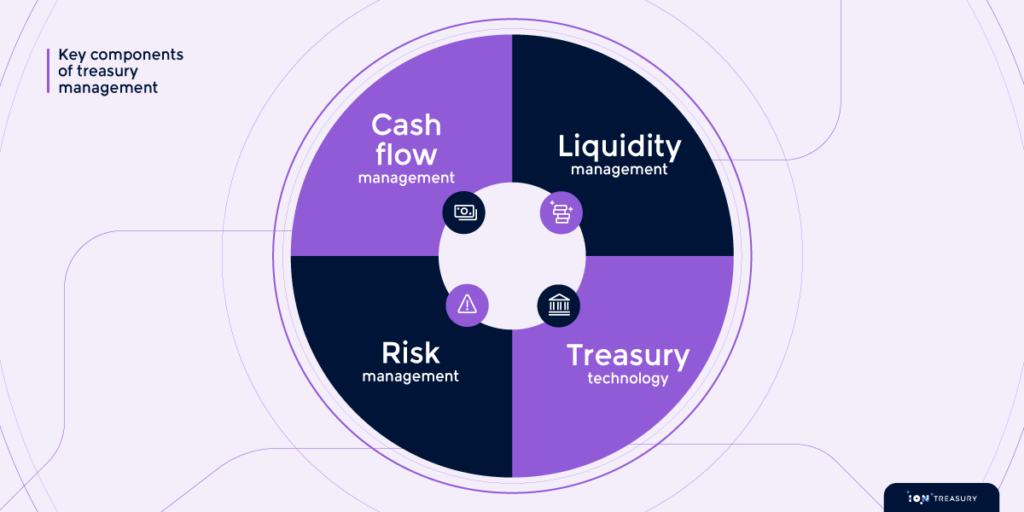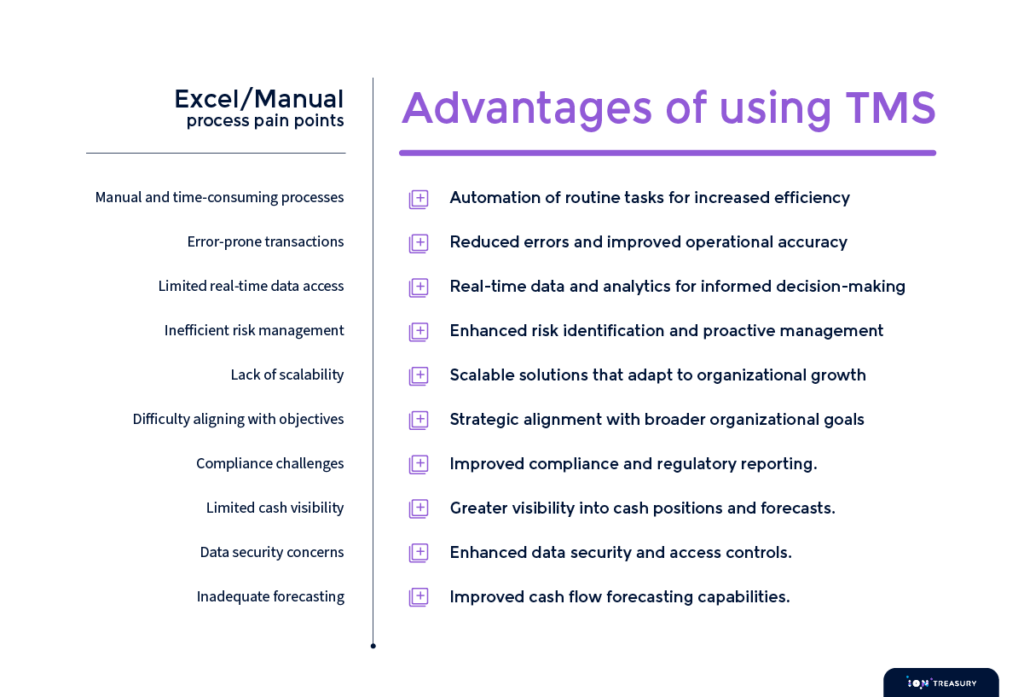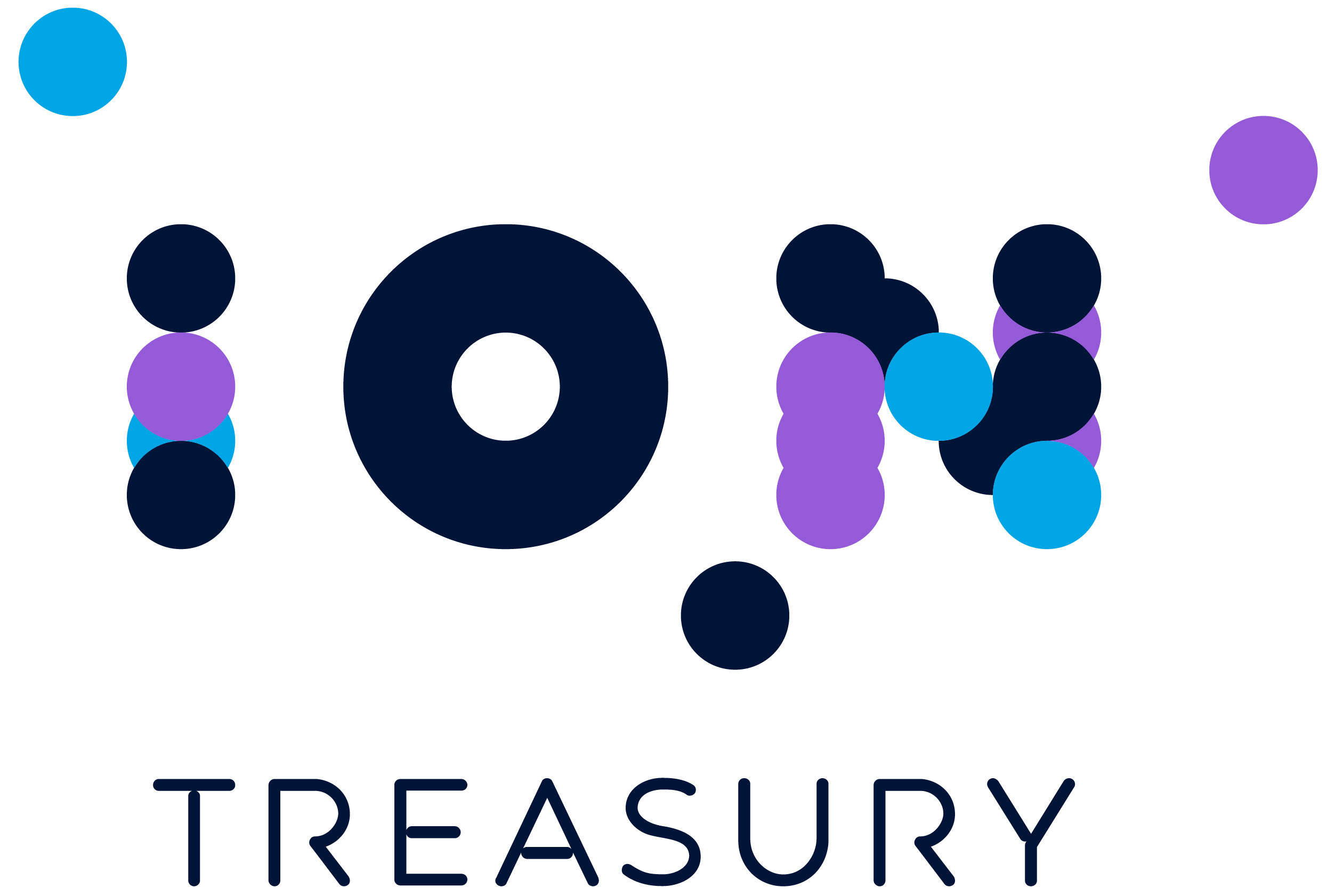Understanding treasury management: a comprehensive guide
The basics of treasury management
Treasury management is vital for financial stability and growth. Let’s start by understanding its fundamental principles and objectives.
What is treasury management?
Treasury management is the strategic management of an organization’s financial assets, liabilities, and liquidity to achieve specific goals. It involves overseeing and optimizing financial resources through a range of functions and responsibilities, including:
- Cash management: Efficiently managing the inflow and outflow of cash to ensure the organization always has the necessary funds available.
- Liquidity management: Maintaining an appropriate level of liquidity to meet financial obligations while maximizing returns on excess cash.
- Risk management: Identifying, assessing, and mitigating financial risks, such as currency exchange rate fluctuations, interest rate changes, and credit risks.
- Investment management: Making informed investment decisions to generate returns on surplus funds while minimizing risk.
- Debt management: Managing debts and liabilities to optimize borrowing costs and repayment schedules.
- Compliance and regulatory affairs: Ensuring the organization complies with financial regulations and reporting requirements.
Objectives of treasury management
The primary objectives of treasury management revolve around enhancing an organization’s financial health and stability. These objectives can vary from one organization to another, but they typically include:
- Optimizing cash flow: Maintaining a healthy cash flow is essential for day-to-day operations, and treasury management ensures the organization has sufficient cash available.
- Minimizing financial risk: Identifying potential risks and implementing strategies to mitigate them, reducing exposure to market volatility and financial losses.
- Maximizing returns on investments: Safely invest surplus funds to earn returns through short-term instruments like money market funds or longer-term investments in bonds or equities.
- Cost-effective debt management: Managing debts efficiently to minimize borrowing costs and optimize the organization’s capital structure.
- Ensuring regulatory compliance: Staying compliant with financial regulations and reporting requirements to avoid penalties and legal issues.
- Supporting strategic decision making: Providing financial data and insights to support strategic decisions, such as mergers and acquisitions, capital investments, and expansion plans.
Key Takeaway
Effective treasury management involves a delicate balance between these objectives, tailored to meet the specific needs and goals of the organization. It requires a keen understanding of financial markets, risk assessment, and adapting to changing economic conditions.
As we move forward in this guide, we will dive deeper into each aspect of treasury management, exploring strategies, best practices, and real-world examples that showcase its importance in achieving financial success. From optimizing cash flow to managing risk and harnessing the power of technology, our journey through the world of treasury management promises to be both enlightening and empowering.
Key components of treasury management
This section delves into the critical components of treasury management that underpin an organization’s financial stability and success. We begin with an exploration of cash flow management, followed by liquidity management, and conclude with an examination of risk management.

Cash flow management
Cash flow is the lifeblood of any organization, and its effective management is paramount. It involves tracking the movement of money in and out of the company, ensuring that there is enough cash on hand to meet immediate financial obligations while optimizing the allocation of surplus funds. The importance of cash flow management can be summarized in the following ways:
- Solvency: Adequate cash flow ensures the organization can meet its short-term financial commitments, preventing insolvency.
- Operational stability: Smooth cash flow keeps daily operations running smoothly, enabling the company to pay suppliers, employees, and other stakeholders promptly.
- Strategic decision making: Accurate cash flow forecasts enable better planning and informed decision-making regarding investments, expansions, and cost management.
4 strategies for optimizing cash flow:
- Effective receivables management: Timely invoicing and a robust credit control system can reduce the time it takes for customers to pay.
- Efficient payable management: Negotiating favorable terms with suppliers and optimizing payment schedules can help preserve cash.
- Cash flow forecasting: Regularly forecasting cash flow helps identify potential shortfalls and surpluses, allowing for proactive adjustments.
- Working capital management: Streamlining working capital components, such as inventory and accounts payable, can free up cash.
Liquidity management
Liquidity management involves maintaining an appropriate level of readily accessible assets to meet financial obligations as they arise. Liquidity is crucial for several reasons:
- Risk mitigation: Liquidity is a buffer against unexpected expenses, economic downturns, or disruptions in cash flow.
- Investment opportunities: Having liquid assets allows organizations to capitalize on investment opportunities, such as acquiring assets or expanding operations.
- Operational flexibility: Liquidity provides the flexibility to take advantage of discounts, negotiate favorable terms, or fund strategic initiatives.
4 techniques for effective liquidity management:
- Cash reserves: Maintain cash reserves in easily accessible accounts to cover short-term obligations.
- Asset management: Invest surplus funds in short-term, low-risk instruments like money market funds to earn modest returns while preserving liquidity.
- Credit facilities: Establish credit lines or overdraft facilities as backup sources of liquidity in times of need.
- Optimize cash conversion cycle: Streamline processes to reduce the time it takes to convert inventory into cash while extending the time to pay suppliers.
Risk management
Treasury management is pivotal in identifying, assessing, and mitigating financial risks. These risks may include:
- Market risk: Exposure to fluctuations in interest rates, exchange rates, and commodity prices.
- Credit risk: The risk of counterparties failing to meet their financial obligations.
- Operational risk: Risks associated with internal processes, systems, or human error.
- Liquidity risk: The risk of being unable to meet short-term financial obligations.
Risk mitigation strategies and tools:
- Diversification: Spread investments across different assets or markets to reduce exposure to a single risk.
- Hedging: Use financial instruments like derivatives to protect against adverse price movements, such as currency hedging.
- Credit assessment: Conduct thorough credit assessments of counterparties and establish credit limits.
- Contingency planning: Develop contingency plans to address risks and ensure business continuity.
In mastering these key components of treasury management, organizations can safeguard their financial health, seize opportunities, and confidently navigate challenges. Treasury management is not merely about financial prudence but empowerment and resilience in the ever-evolving finance landscape.
Treasury operations
In this section, we delve into the operational aspects of treasury management, essential for the day-to-day financial activities of an organization. We’ll explore the significance of the intricacies of cash forecasting.
Cash forecasting
Cash forecasting is critical to treasury management, providing visibility into future cash flows. The process involves the following steps:
- Data collection: Gather historical financial data, accounts receivable and payable information, and sales projections.
- Analysis: Analyze the collected data to identify cash flow patterns, trends, and seasonality.
- Forecasting models: Use forecasting models, such as time series analysis or scenario-based forecasting, to project future cash flows.
- Regular updates: Continuously update the cash forecast based on changing circumstances and new information.
Tools and methods for accurate cash forecasting:
- Cash flow software: Use specialized cash flow forecasting software that automates data collection and analysis.
- Budgets and forecasts: Integrate cash forecasting into your budgeting and financial planning processes.
- Scenario analysis: Consider various scenarios, including best-case and worst-case, to assess possible outcomes.
- Regular monitoring: Regularly compare actual cash flows to forecasts and adjust the forecast as needed.
- Machine learning: Leverage machine learning algorithms to improve the accuracy of cash forecasting by analyzing historical data and identifying patterns and trends.
Compliance and regulatory considerations
Adherence to financial regulations and robust security measures is paramount in treasury management. This section explores the critical aspects of compliance and data security, shedding light on the regulatory landscape and strategies to protect financial assets.
Financial regulations
Treasury management operates within a framework of financial regulations, which may vary by jurisdiction and industry. Here’s an overview of some of the common regulations that impact treasury management:
- Sarbanes-Oxley Act (SOX): Mandates strict financial reporting and internal control requirements for publicly traded companies in the United States.
- Basel III: Provides international banking standards aimed at enhancing bank capital adequacy and liquidity.
- Anti-Money Laundering (AML) Regulations: Require financial institutions to implement measures to detect and prevent money laundering activities.
- International Financial Reporting Standards (IFRS): Global accounting standards that impact financial reporting and disclosures.
- US Generally Accepted Accounting Principles (US GAAP): Accounting principles and standards used in the United States, which impact financial reporting and disclosure requirements.
How compliance affects treasury management:
Compliance with financial regulations significantly influences treasury management in several ways:
- Reporting and documentation: Treasury teams must maintain accurate records and documentation to meet regulatory reporting requirements.
- Risk mitigation: Compliance frameworks often include risk assessment and management guidelines to minimize financial risks.
- Liquidity and capital adequacy: Regulations may stipulate liquidity and capital adequacy ratios that impact treasury operations.
- Transparency: Regulatory compliance enhances transparency, which is essential for investors, regulators, and stakeholders.
Data security and fraud prevention
Data security is a critical aspect of treasury management, given the sensitivity of financial information. The importance of data security includes:
- Confidentiality: Protecting sensitive financial data from unauthorized access ensures confidentiality.
- Integrity: Data integrity safeguards against unauthorized modifications or tampering with financial information.
- Availability: Ensuring financial systems and data are available to support business operations.
Key Takeaway
Maintaining financial regulations and robust data security measures are non-negotiable aspects of treasury management.
Strategies to prevent fraud and protect financial assets:
- Access controls: Implement strict user access controls and authentication mechanisms to restrict access to financial systems and data.
- Encryption: Encrypt sensitive financial data during storage and transmission to prevent unauthorized interception.
- Regular audits: Conduct internal and external audits to identify vulnerabilities and irregularities.
- Employee training: Train employees on security best practices, emphasizing the importance of safeguarding financial data.
- Incident response plans: Develop and regularly update plans to address potential security breaches promptly.
- Vendor due diligence: Vet third-party vendors and service providers for their security measures, mainly if they handle financial data.
- Multi-factor Authentication: Require multi-factor authentication for critical financial transactions and system access.
Financial regulations and data security measures safeguard financial assets, protect stakeholders’ interests, and maintain the trust and integrity of the organization’s financial operations. These considerations are central to effective treasury management in an increasing cyber threats and regulatory scrutiny era.
Treasury technology
Technology is transformative in modern treasury management, enabling organizations to streamline operations, enhance decision-making, and adapt to evolving financial landscapes. This section delves into a critical aspect of treasury technology- Treasury Management Systems (TMS).
The strategic significance of TMS
A Treasury Management System (TMS) is the nerve center of treasury operations. It is a central hub for managing an organization’s financial resources, optimizing cash flow, and mitigating risks. The strategic significance of TMS can be categorized as follows:
- Streamlined operations: TMS automates and streamlines manual treasury processes, reducing the risk of errors and increasing operational efficiency.
- Enhanced visibility: TMS provides real-time visibility into cash positions, liquidity, and financial risks, empowering treasury professionals with data-driven insights.
- Risk mitigation: With risk management modules, TMS assists in identifying, measuring, and mitigating financial risks, such as currency exchange rate fluctuations and interest rate risks.
- Compliance and reporting: TMS simplifies compliance with financial regulations by automating reporting and ensuring adherence to standards and guidelines.
Advantages of implementing a TMS
Implementing a Treasury Management System offers a wide array of advantages for organizations:

Selecting the right TMS solution
Selecting the right TMS is a pivotal decision that requires careful consideration. Key factors in evaluating when choosing a TMS solution include:
- Functionality: Assess the comprehensiveness of the TMS in terms of cash management, liquidity forecasting, risk management, and reporting capabilities.
- Scalability: Ensure the TMS can accommodate your organization’s growth and evolving needs.
- Integration: Check whether the TMS can seamlessly integrate with existing systems, banking partners, and third-party applications.
- User friendliness: User-friendly interfaces and ease of navigation are crucial for effective adoption.
- Cost considerations: Understand the total cost of ownership, including licensing fees, implementation costs, and ongoing maintenance expenses.
A Treasury Management System is not merely a technological investment; it’s a strategic enabler that empowers organizations to navigate the intricate world of finance with confidence. From automating routine tasks to offering real-time insights, a well-implemented TMS can revolutionize treasury operations, ensuring financial health and resilience in an ever-changing economic landscape.
Evolving demands on corporate treasurers
The role of corporate treasurers is undergoing a significant transformation in response to the rapid shift of economic activity from established markets in Europe and North America to developing ones in Africa, Asia, and Latin America. CFOs are increasingly looking to treasurers to enhance their performance, particularly as the pace of growth and regulatory changes continue to challenge even the most established treasurers. In this section, we explore the evolving demands on corporate treasurers and provide insights into how they can adapt to meet these challenges.
The demands on corporate treasurers have evolved due to several key factors:
- Global Expansion: Companies are expanding into emerging markets, facing diverse banking protocols, languages, and customs. Treasury departments find it challenging to navigate these complexities.
- Core activities: Treasurers are expected to excel in core activities, including cash management, banking, debt and funding, investments, and risk management for currencies and interest rates. Shortcomings in these areas can have significant financial implications.
- Operational inefficiencies: Many organizations retain decentralized treasury components, resulting in excessive bank accounts and operational inefficiencies. This lack of centralization can lead to inaccurate forecasting and suboptimal cash management.
- Risk mitigation: Treasurers mitigate financial risks, such as currency fluctuations and interest rate risks. Inadequate risk management can lead to unnecessary expenses and financial losses.
- Governance and oversight: Effective governance is crucial to prevent fraud and mismanagement, particularly in regions with weak or nonexistent governance standards. Treasurers must strengthen governance through policies, processes, and training.
- Technology adoption: The treasury landscape has seen significant technological advancements, with TMS and other tools becoming more sophisticated. Treasurers must decide whether to invest in these technologies and integrate them into their operations.
- Cash flow forecasting: Accurate forecasting is essential for financial planning and liquidity management. Many treasurers acknowledge that their global cash flow forecasts are inaccurate or incomplete, highlighting the need for improvement.
- Working capital management: Managing working capital efficiently presents unique challenges, especially in developing markets. Treasurers must adapt to differences in payment terms and business cultures while optimizing cash.
Addressing the evolving demands: a strategic approach
To thrive in this changing landscape, treasurers should consider the following strategic approaches:
- Centralize the treasury function globally: Move toward centralization to consolidate policy setting, decision-making, and execution. While maintaining some regional flexibility, centralization enhances visibility and control over cash flow and risk positions.
- Strengthen governance: Conduct thorough reviews of policies and processes, test them under stress, and provide comprehensive training to prevent fraud and mismanagement.
- Enhance TMS: Embrace advanced TMS solutions to automate and streamline treasury operations, reduce errors, and improve data integration.
- Improve cash flow forecasting: Analyze cash flow forecasts rigorously, consult with global business units, run stress scenarios, and provide better intelligence for cash utilization.
- Manage working capital in developing markets: Address the complexities of working capital management by understanding regional payment terms, customer behavior, and cultural differences.
Incorporating these strategies can help corporate treasurers meet the evolving demands of their roles and contribute more effectively to their organizations’ financial success.
Key Takeaway
Adaptability and a proactive approach are crucial to thriving in today’s dynamic business environment.
Treasury management is a multifaceted discipline pivotal to an organization’s financial well-being and resilience. As the global economic landscape continues to evolve and present new challenges, treasurers must adapt, innovate, and embrace strategic approaches to effectively meet the demands of their roles. From optimizing cash flow and mitigating risks to harnessing the power of technology and maintaining strict compliance, treasury management is a dynamic field that requires continuous learning and adaptation.

Don't miss out
Subscribe to our blog to stay up to date on industry trends and technology innovations.

